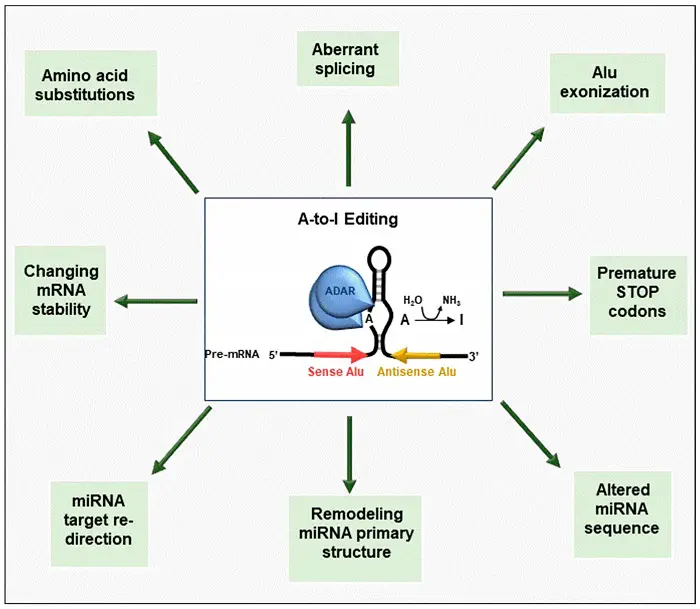RNA editing is a post-transcriptional modification process that alters the nucleotide sequence of RNA molecules. This leads to changes in the RNA sequence and, consequently, the RNA’s protein-coding potential or regulatory functions. RNA editing can occur in various types of RNA, including messenger RNA (mRNA), transfer RNA (tRNA), ribosomal RNA (rRNA), and non-coding RNA (ncRNA).
Types of RNA Editing
There are several types of RNA editing, but the most common types involve the conversion of one nucleotide to another or inserting or deleting nucleotides. The two main types of RNA editing are:
1. Substitution Editing:
-
- Substitution editing involves the conversion of one nucleotide to another within the RNA sequence. This type of editing can result in new codons, changes in amino acid sequence, and alterations in protein function.
- One example of substitution editing is adenosine-to-inosine (A-to-I) editing, catalyzed by enzymes called adenosine deaminases acting on RNA (ADARs). In this process, specific adenosine residues within RNA molecules are deaminated to form inosine, recognized as guanosine during translation.
- A-to-I editing is particularly common in mammalian cells and can alter protein function, alternative splicing patterns, and RNA stability regulation.
2. Insertion/Deletion Editing:
-
- Insertion/deletion editing involves adding or removing nucleotides from the RNA sequence. This type of editing can result in frame-shift mutations, changes in RNA secondary structure, and alterations in RNA stability or processing.
- One example of insertion/deletion editing is uridine insertion editing in trypanosome mitochondria. In this process, specific uridine residues are inserted into the mRNA sequence by RNA editing complexes, creating functional open reading frames and generating mature mRNA molecules.
RNA editing is essential in gene regulation, RNA processing, and protein diversity in various organisms. It can provide a mechanism for generating transcriptomic and proteomic diversity from a relatively small number of genes and fine-tuning gene expression and protein function in response to environmental cues or developmental signals.
Application of RNA (Ribo Nucleic Acid) Editing
RNA editing is a process by which RNA sequences are altered after transcription, leading to changes in the final protein products. This process occurs naturally in cells and has several critical applications across various fields. Here are some notable applications of RNA editing:
- Gene Therapy: RNA editing holds promise for treating genetic disorders caused by single nucleotide mutations. By using tools like CRISPR-based systems or engineered adenosine deaminases, correcting disease-causing mutations at the RNA level is possible, providing a potential avenue for therapeutic intervention.
- Studying RNA Function: RNA editing can be used to investigate the functional consequences of specific RNA sequence changes. Researchers can study how these alterations affect RNA stability, splicing, localization, and translation by introducing or correcting mutations in RNA transcripts.
- Creating Disease Models: RNA editing technologies enable the generation of cellular or animal models that accurately mimic specific genetic diseases. By introducing disease-associated mutations into RNA transcripts, researchers can study the pathophysiology of these conditions and screen potential therapeutic interventions.
- Biotechnology and Protein Engineering: RNA editing can be employed to engineer RNA sequences for various biotechnological applications. For example, researchers can introduce specific amino acid changes into RNA transcripts to generate novel protein variants with desired properties, such as increased stability or altered enzymatic activity.
- Drug Development: RNA editing can be leveraged in drug discovery and development efforts. By modulating RNA sequences in disease pathways, researchers can identify potential drug targets and develop RNA-targeted therapies for various diseases, including carcinomas, neurodegenerative disorders, and viral infections.
- Studying RNA Virus Evolution: RNA viruses, such as HIV and influenza, exhibit high mutation rates due to the error-prone nature of their RNA polymerases. RNA editing tools can study viral evolution by introducing specific mutations into viral RNA genomes and observing how these changes affect viral fitness, transmission, and drug resistance.
- RNA-based Therapeutics: RNA editing technologies enable the development of RNA-based therapeutics, including RNA vaccines, RNAi therapies, and RNA mimics. By modifying RNA sequences to enhance stability, specificity, or immunogenicity, researchers can improve the efficacy and safety of RNA-based drugs for clinical use.
- Synthetic Biology: RNA editing can be utilized in synthetic biology to engineer cells with custom-designed RNA sequences and functions. By precisely editing RNA transcripts, researchers can create synthetic gene circuits, regulatory networks, and biosensors for biotechnology, bioenergy, and biomedicine applications.
Overall, RNA editing is a dynamic and highly regulated process that contributes to the complexity and diversity of the transcriptome and proteome in living organisms. It has implications for various biological processes, including development, differentiation, disease, and evolution.
